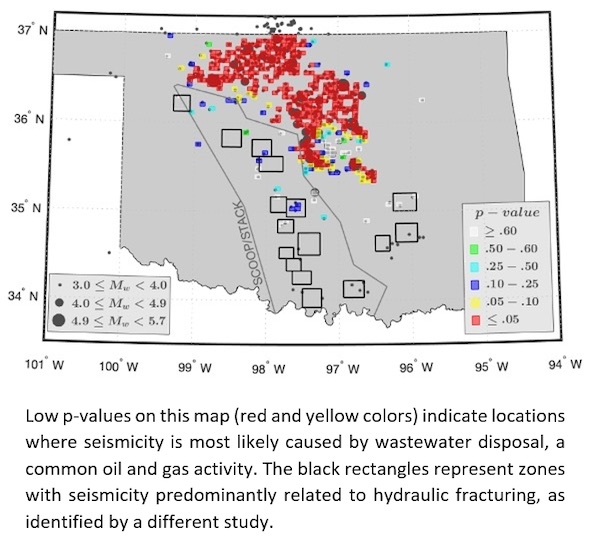Earthquakes Induced by Wastewater Injection, Part II: Statistical Evaluation of Causal Factors and Seismicity Rate Forecasting

Iason Grigoratos, Ellen Rathje, Paolo Bazzurro, and Alexandros Savvaidis
Bulletin of the Seismological Society of America, 2020, https://doi.org/10.1785/0120200079
Study Summary
Wastewater disposal has been reported as the main cause of the recent surge in seismicity rates in several parts of the central United States, including Oklahoma. In this article, we employ the semiempirical model of Part 1, the companion to this article (see DOI 10.1785/0120200078), first to test the statistical significance of this prevailing hypothesis and then to forecast seismicity rates in Oklahoma given future injection scenarios.
The results show that the vast majority (76 percent) of the seismically active blocks in Oklahoma can be associated with wastewater disposal at a 95 percent confidence level. These blocks experienced 84 percent of the felt seismicity in Oklahoma occurring after 2006, including the four largest earthquakes. This observation strongly supports the consensus of the scientific community that the main cause of the rise in seismicity is indeed wastewater disposal.
In terms of forecasting power, the model is able to predict the evolution of the seismicity burst starting in 2014, both in terms of timing and magnitude, even when only using seismicity data through 2011 to calibrate the model. Under the current disposal rates, the seismicity is expected to reach the pre-2009 levels after 2025, whereas the probability of a potentially damaging earthquake with magnitude Mw ≥ 5.5 between 2018 and 2026 remains substantial at around 45 percent.
Why is this research important and why do the results matter?
So far either qualitative considerations or arbitrary numerical thresholds were used to establish a probable causal link between increased seismicity and oil and gas activities.
- Our study provides a novel statistical framework to quantitatively determine in which areas the seismicity is driven by fluid injection.
- The findings of our study strongly support the consensus of the scientific community that the main cause of the rise in Oklahoma's seismicity is indeed wastewater disposal. However, we also identified several areas where alternative causal factors need to be investigated.
- In terms of forecasting power, the developed earthquake recurrence model is able to predict the evolution of the seismicity burst early on with limited data, indicating that it can be used as a monitoring tool.
- The study also presents data against the use of elevated b-values, commonly adopted by other researchers, when estimating the occurrence probabilities of potentially damaging earthquakes.